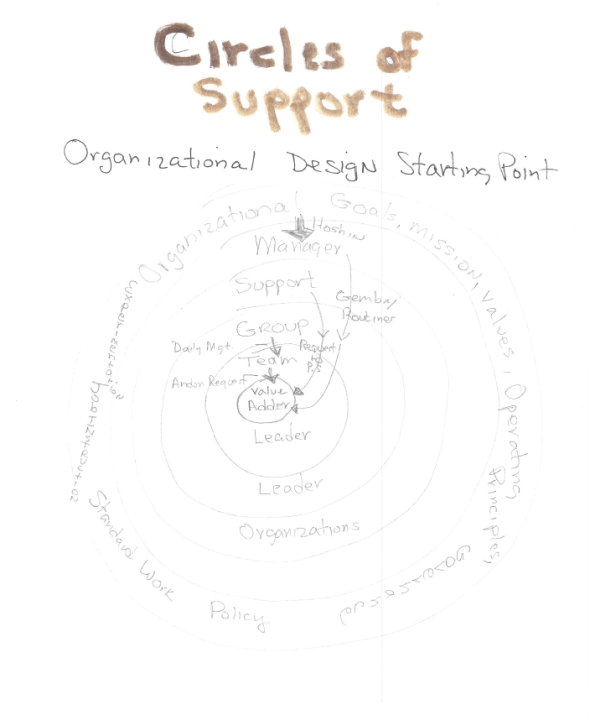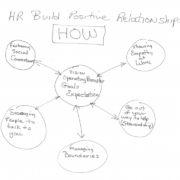The Role of HR in a Continuous Improvement Organization: Organizational Structure
(Reposted by permission of the author from LinkedIn)
Form follows function – that has been misunderstood. Form and function should be one, joined in a spiritual union. – Frank Lloyd Wright
This is significant for many reasons but what he realized was that if the design of anything reverses this, then you are only lucky if your design is proven successful. Even more importantly, it is the joining of both form and function that create great design and results. If you look at his designs you are struck by their external beauty and if you have the opportunity to go inside, you are amazed by how functional the living space is supported by the exterior design.
Form following function is also smart and effective because the unintended consequence of not doing this usually leaves the organizational leaders scrambling for status and position, losing the essence of what the organization is all about. I have seen this happen so many times when the people that name the positions leave it up to the employee who fills that position to determine what the role is. Most assume that with the position, they can set up their functions as they wish. The first question they ask is how many people report to them and how many peers they have. With this knowledge they feel they can proceed without even understanding the function and the aim of the organization. Their intention is to set up their organization to shine light on their performance.
Organization and reorganization are a necessary element of any company and should receive at least the same amount of preparation as a new machine being set in place would. In fact, most organizations who purchase a new machine would never proceed without making sure the machine is reliable, can produce quality and has a plan for how it would get maintained.
So, why would a system that impacts the entire operation, determines the output and delivers value to the customer be any less important? The answer is self-evident. Of course, this highlights how important the foundation or function coupled to the form of the organization structure is to accomplishing the mission of the organization.
However, this generates some very important questions for design. Where will support for the person adding value come from? We all know nothing achieves perfection all of the time. Where do you begin in our quest for good organizational structure? How does this effect decision making? How will all of this effect the satisfaction of the customer? How can organizational structure help create mutual trust and respect?
Let’s first discuss the importance of support in an organization. All organizations have targets for satisfying the customer. Some believe that you produce as much as you can and sort out the good to go to the customer. This type of organization believes once you teach the person their job they don’t need support and if they do then to keep it within a minimally prescribed amount of time. All of this is driven by the production schedule and in a lean organization you want to have the least waste possible. This means that once the preceding process is finished, the following process must be finished with their input and ready to receive the product with no lost time. This synchronization sets the span of support for each of the value adders and the Team Leader. This response time is ideally zero. However, this is not realistic and must be consistent with what the process requires and needs. If the product is more complex, the support has to be longer and the response time shorter. If the level of competency is high the response time can be longer because the identification of the problem is quicker which allows the process to proceed in synchronization. Support becomes important because the time taken to diagnose a problem needs to be shorter, with the work inside the process by the Team Leader creating a temporary countermeasure with the potential to not stop the line at all. In addition, support with a sense of urgency delivers a very important message: “You the value adder are the most important position in the organization”. Support should not only keep the process flowing but provide the way for the system to adapt to changes. In the end, the organization must have a span of support that allows the Team Leader to enter the process, determine the issue and put in place a temporary countermeasure. Even if the countermeasure solves the issue the Team Leader is responsible to make sure this problem never occurs again through changes to the standard work.
The second issue in design is the question about where each of the roles in a product delivery system begins and ends. For many organizations, this decides the boundaries for all the roles and set up the battle over whether it is one person’s job or another. In design of continuous flow it is a waste to spend any time on sorting this out. The only question is how the competencies are set up by role and how they are to be executed.
The ideal execution is to replace this role boundary discussion with accountability expectations.
Everyone in the organizational structure is taught that they are accountable for a variety of tasks and the usage of them is not bound by boundaries. If you see something that needs your attention, give it. If you don’t have the competency, develop it. If you are asked to be part of the decision-making process, grasp it through your support. If you find a positive solution to a problem, standardize it. If you see something that needs to change, construct the logic in a problem solving structure and try it. If it works, then seek out support to make it a standard. The message in a non-blame culture is to do whatever is logical to satisfy the customer by proving your thinking. If you don’t know how to proceed ask for help. The organizational design becomes your support for solving problems and creating improvement.
The third issue of organizational structure is the process of governing the process or governance. The form of governance that supports the value adder is one that is constantly looking for facts and causes, not blaming someone for a shortfall. Everyone in the organization understands that solving problems is a great way to develop someone. So how should someone proceed in this kind of an environment? First, define a problem as a deviation from a standard or a known expectation. If a standard or expectation does not exist, then create one. Seek out the people in the organization that are affected by the issues and get their buy-in to your solution with their support. All solutions are documented in a common critical thinking process so the language of improvement is common. What is sought is the support of those involved to try an experiment to prove if the idea is valid. Usually, with minor adjustments, agreement to proceed with the experiment is given to determine what is the true value of the idea. At the end of the agreed time for the experiment, final support for full implementation is sought with the facts in hand. Solving problems become both a learning opportunity and a matter of mutual accountability.
 What these three issues signify is that the organizational structure is set up to support and allow accountability to take place. The organizational structure cannot be bureaucratic and position protecting. Everyone has their role. The roles are for protecting the reliability of the process and the form it takes has to be consistent with maintaining customer satisfaction and developing individuals to do inspired work.
What these three issues signify is that the organizational structure is set up to support and allow accountability to take place. The organizational structure cannot be bureaucratic and position protecting. Everyone has their role. The roles are for protecting the reliability of the process and the form it takes has to be consistent with maintaining customer satisfaction and developing individuals to do inspired work.
These three issues provide the basis of the organizational structure. If form does follow function to achieve excellence in design, then each of these issues need to be embedded into the design first and then the boxes constructed to accommodate them. This is why circles of support are critical to the smooth functioning of accountability.
Since organizational design should start with the value adder and the customer is satisfied through their created value, it is now apparent that there should be circles of support around them. This support should be a complete support starting with all the things that make up the organization’s mission, vision, goals and operating principles. The idea of concentric circles is that the reliability of the system is based on the reality that you can enter it at any point in this organization and experience the same culture. Those who add value experience it most strongly because the rest of the entire organization is asking “how can we support you”? This includes the governance system that is both a check and balance but an avid supporter of change through experimentation. The keys are that you run an organization on facts, and a common language of problem solving is spoken, as a result control for all change is through discovering or collecting facts to assess if the organization is indeed supporting the value adders, people are being developed and improvement is a constant state.

 2019, Total Systems Development, Inc.
2019, Total Systems Development, Inc.
 2019, Total Systems Development
2019, Total Systems Development 2019, Total Systems Development, Inc.
2019, Total Systems Development, Inc.

 Total Systems Development, Inc., 2019
Total Systems Development, Inc., 2019
 2019, Total Systems Development, Inc.
2019, Total Systems Development, Inc. 2019, Total Systems Development, Inc.
2019, Total Systems Development, Inc.